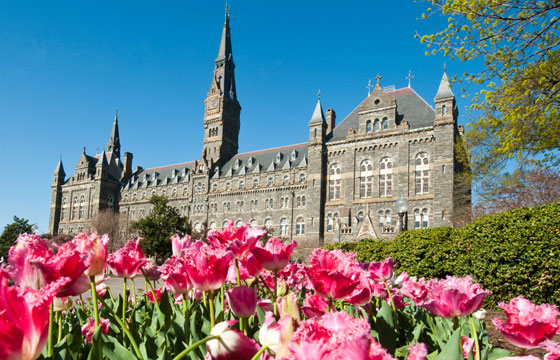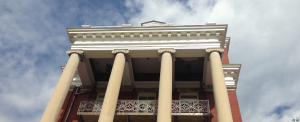Any student stepping onto campus for the first time will inevitably walk in the looming shadow of Healy Hall. The prominent building, once the tallest structure in Washington, also carries with it a complex history of the man whose name it bears.
The building is named for Fr. Patrick Healy, SJ, who served as the president of Georgetown from 1873 to 1882 and is often referred to as the university’s “second founder.” Though white-passing by appearance, Healy is considered the university’s first Black president, as well as the first African American president of a predominantly white educational institution in America and the first to receive a doctorate in the United States. Healy is accredited with growing Georgetown from a local college into a renowned university, having led massive building projects and curriculum reform during his tenure. He achieved this despite being born enslaved to Michael Healy, an Irish plantation owner, and to Eliza Clark, an enslaved woman who was part European and part African American.
The Voice spoke with Adam Rothman, associate professor of history at Georgetown, about the history and legacy of Healy. “There’s something remarkable about Patrick Healy starting out in bondage and then rising to become the president of Georgetown—but it’s not a feel-good story,” Rothman said. “It’s a story littered with loss and tragedy and tradition. I think people have to keep that in mind.”
According to Rothman, Healy’s father sent him and his siblings to the North to be educated in Catholic schools. Healy and his siblings were baptized shortly after arriving at the College of the Holy Cross in 1844 and received their Confirmation the following year. They excelled at Holy Cross, with Healy ranking first in his class in 1849. Healy rose through the ranks of the Catholic order, even teaching as a professor, and after his graduate studies in Europe came to Georgetown as a philosophy professor in 1866.
Healy and his brothers’ successes occurred mainly within the Catholic community, with Healy’s brother James serving as the second bishop of Portland, Maine from 1897 to 1900. “They find a place for themselves within the world of American Catholicism, but it’s not a race-blind world by any stretch of the imagination,” Rothman said. “So the only way that he can really rise up in the ranks is essentially to pass for white.”
Healy was a Black man according to 19th-century racial classifications, known historically as the “one-drop rule,” but most of the world perceived him as white. This wasn’t the case for all of his siblings. According to Rothman, one of Healy’s brothers, Sherwood, had a darker complexion and couldn’t “pass” like his brothers. “Patrick and the other siblings really keep their distance from [Sherwood] because they can’t be seen with him—they can’t affiliate or associate with him,” Rothman noted.
James O’Toole, a professor of history at Boston College, is a leader in scholarship about the Healy family, Rothman added. In an essay adapted from his book “Passing for White: Race, Religion, and the Healy Family” (2002), O’Toole explained that when Healy was at Georgetown, the Jesuits were aware of his biracial ancestry. On campus, Healy’s students and peers speculated he had Spanish ethnicity. “The Jesuits, knowing of Patrick’s background, took the precaution of assigning him to teach within the university’s separate division for the training of Jesuits,” O’Toole wrote. When Healy was considered as a candidate for president of the college, concerns over appointing a Black president were discussed but did not overshadow Healy’s merit and qualifications for the job.
The existence of a strong southern Confederate community in the student body contributed heavily to secrecy regarding Healy’s heritage, as his tenure at Georgetown as president in the 1870s came on the tails of the Civil War. According to Rothman, the vast majority of Georgetown students and alumni who fought in the Civil War fought for the Confederacy and the preservation of slavery, and before the war, the university had southern empathies. It was during Healy’s time as president that the university adopted the blue and grey colors to symbolize reconciliation between the Union (blue) and Confederacy (grey). “He is the president while this reconciliation among white Americans takes place at Georgetown. And again, in this context there’s no way that he could reveal, acknowledge or embrace any kind of Black identity,” Rothman said.
Despite being born into slavery, Healy directly participated in the slave trade of the era. An article published in the Smithsonian Magazine in September of 2020 outlined Healy’s relationship with slavery. Healy’s white father, a wealthy cotton farmer, owned as many as 49 enslaved people on the 1500 acres he owned. When Healy’s father died, Healy and his siblings inherited the family’s slaves. When a fire destroyed Holy Cross’s main academic building, Healy, at that time a university employee, made a major donation to the rebuilding by selling the inherited slaves.
Roughly 20 years prior to Healy’s sale of his inherited slaves to salvage Holy Cross, Georgetown President Thomas Mulledy sold 272 slaves in 1838 to save the university from financial decline. Mulledy went on to become the first president of Holy Cross in 1843 and had close ties to Healy as a listed guardian of the Healy siblings in Michael Healy’s will if their father’s first choice should predecease him.
The history of the 272 sold by Georgetown is known by many current students, but knowledge of the extent of Georgetown’s complicity in slavery ebbs with graduating classes. In 2019, students passed a referendum to create a reconciliation contribution to benefit the descendants of the 272 sold slaves. “It’s worth noting that students have been doing research on this for a long time and it seems like every new cohort of Georgetown students has to learn the story again for themselves,” Rothman said. In fact, in 2010 the Voice’s blog Vox Populi interviewed Matt Sheptuck (COL ’10), who wrote his American Studies senior thesis on the changing perception of Healy’s race by the University over the years.
According to Sheptuck, from the 1880s to the 1950s, Georgetown “failed to try to mention Patrick Healy’s African-American identity or birth to a slave mother at all.” It wasn’t until the 1960s, in the wake of the Civil Rights movement, that Georgetown began to acknowledge Healy as a Black American. During the centennial celebration of Healy’s tenure in 1973-1974, then-President Robert Henle created a steering community that hosted events putting Healy in the context of a Black American, and pamphlets were printed with the title: “Patrick Healy, SJ, A Black Man’s Dream Come True.”
There has been a fair amount of scholarship and discourse around Healy’s heritage, how he chose to identify, and how he should be identified today. According to Sheptuck, while Healy publicly identified as white during his life that bears no relevance to his private and contemporary identification. “That identity was adopted under constrained social confines,” Sheptuck noted. “If Healy was alive today, we have no idea how he would identify.”
Questions about Healy’s self-identification have since been taken up by students and academics alike. In April of 2020, the Black Book of Georgetown was released to the student body, which provides Black students with resources on- and off-campus as well as outlines the Black history at Georgetown. The book names Healy as the university’s first Black president as part of Georgetown’s Black legacy. In 2006, Carroll Gibbs, author of “Black Georgetown Remembered,” spoke at the university and credited Healy in his role as the first Black president of a predominantly white institution.
According to Rothman, celebrations of Healy at Georgetown and abroad have to exist within the context of the time and the reality of Georgetown’s history with Black people. Even when Healy was buried in the Jesuit cemetery in 1910, the cemeteries in D.C. were segregated. “We can celebrate Healy as the first Black president of a historically white American university, but you also have to recognize that the first Black students weren’t admitted until the 1950s,” Rothman said.
Even after Healy’s death in 1910, it was more than 40 more years before Georgetown admitted its first Black student. Harvard admitted their first Black undergraduate in 1847, Yale enrolled their first Black student in the 1850s, Middlebury admitted their first Black student in 1821, and in 1835 Oberlin became the first college to admit students without respect to race. Georgetown’s first Black student, Samuel A. Halsey Jr., graduated from the SFS evening school in 1953, and the next Black student would not be admitted to Georgetown College until the 1960s, according to the Black Book of Georgetown.
“Let’s not pretend that the university was some kind of progressive place in the 1870s when it was in fact a bastion of white supremacy and segregation,” Rothman said.






My mother lived on Dent Place NW, and attended Epithany Roman Catholic Church